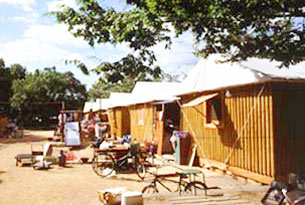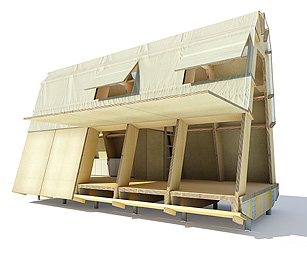 shigeru ban: paper loghouse:
shigeru ban: paper loghouse:
"in june 1995, a great number of people were still
forced to live in shabby tents in parks nearby their
destroyed houses even six month after the earthquake
in kobe. ban's solution was a cheap and simple structure
that could be build by anyone.
the foundation was made of sand-filled beer cases,
the walls of paper tubes and the ceiling and roof of tent
material. the roof and the ceiling were kept separate in
summer to allow air to circulate and closed in winter to
retain warm air. they were easy to recycle after use,
easy to transport, easy to store and the paper tubes
could be made on site.
'the good thing about paper tubes is that they are readily
available in various thickness and diameters.
the weight they can support depends on these two things.
theoretically, I can make buildings a few stories high,
but I haven‘t yet been given the opportunity,’ says ban.
shigeru ban is a pioneer of paper tube structures (PTS),
he investigated the substance and found that not only
could recycled cardboard be molded into load-bearing
columns, bent into beautiful trusses and quickly assembled,
but it could also be made waterproof and fire resistant.
in the space between the paper tubes, self-adhesive
waterproof sponge tape was applied to both sides."



